Hedwig Houben
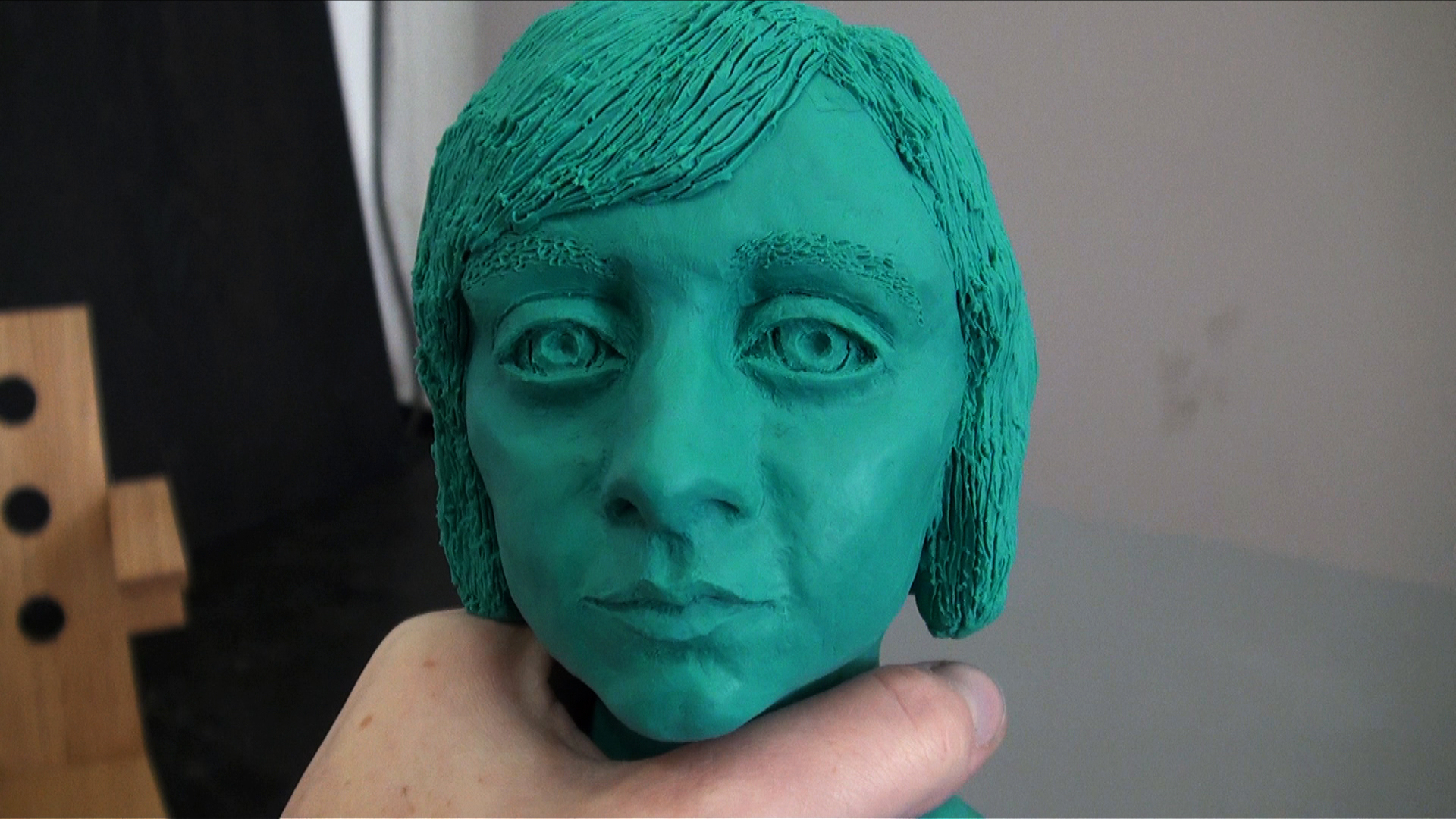
Using wording she is fond of, Hedwig Houben’s work “is, or can be read as, a criticism and a deconstruction of Hedwig Houben’s work by Hedwig Houben”.1
The fact is that Hedwig Houben, to borrow her own words, contributes “as a sort of subject, of volunteer”2 in her own praxis. She also likes describing the sequence of pieces she has been producing since 2009, not as a series, but like an “ongoing conversation”. A conversation in which she is at once her and herself, if we may so put it, or, as she may call herself in one and the same discourse, at once “I” and “the performer”, at once the creator, prey to her personal questions, and the narrator of those questions. She is also one of the interlocutors and, at the same time, or sometimes solely the spokesperson for objects which she thus gets talking. Objects which are like so many vague characters, hesitating between their function as stage prop and their dubious ipseity.
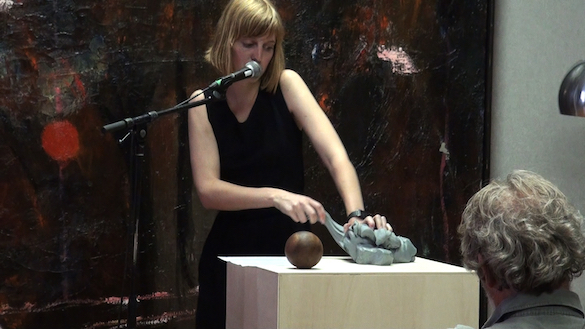
Hedwig Houben, Six Possibilities for a Sculpture II, Ostende, 2010. Video still. Courtesy Galerie Fons Welters, Amsterdam
The story starts under biblical auspices with spaghetti western highlights (unless it’s the other way round) with About the Good and the Bad Sculpture (2009), a hilarious video sketch lasting about four minutes narrated with a perfectly poker-faced, as it were, voice-over, beginning thus: “A few weeks ago, I made these two sculptures. I intended to make one successful sculpture that was very good-looking and one that was not. But something went wrong. The sculpture that was supposed to be the good one turned out to be the failed one.” What is a successful sculpture? For the time being, this question is informing the activity of this young Dutch artist, being also the metonymy of a more basic line of thinking about the nature of art, objects, human behaviour and social life. Yes, all that. All this can stem from the difference between two sculptures. Sculptures in the making, what’s more, because, for Hedwig Houben, the objects she presents are not altogether “works”, they are generally in the process of being made or offering a not yet completely satisfactory result, defining themselves, when it is their turn to speak, as “on standby”—the Rietveld chair of Personal Matters and Matters of Fact (2011) which almost sighs, if a chair can sigh, that is: “Well, I’m already standing here for a while and nothing really happened yet”. The Good and Bad sculptures, which, we learn, were just left in the studio, then, a few years later (The Good, The Bad, The Happy, The Sad (2014)), put on the carpet in the artist’s living room for a few months, and didn’t move, the Good sculpture explaining that they are “waiting, wondering, dreaming and longing, but so far nothing has really happened”—but waiting for what, exactly? Their indeterminate state here is clearly what gives them their strength and interest—who’d like to listen to a sculpture sure of itself and its success? An indeterminate state pushed to its absolute limit in two more recent pieces, The Hand, the Eye and It (2013) and the Hand, the Eye and the Foot (2015), two filmed performances in which an object that is even more uncertain than usual appears, an object which one would have trouble even describing form-and colour-wise, and which one might more accurately describe as a mass akin to a large 50-kilo foetus, made of white, red and brown plasticine, and which the artist has thus called “It”.
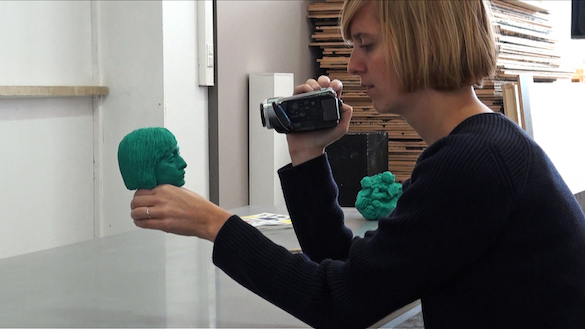

Hedwig Houben, Personal Matters and Matters of Fact, 2011. Video 22’. Video still. Courtesy Galerie Fons Welters, Amsterdam
It is certainly no coincidence if plasticine is Hedwig Houben’s favourite material. It is supple, and can be shaped and re-shaped, so it incarnates the plasticity of forms as well as the impermanence of the objects that are outlined here under the impermanence of forms and a plasticity of objects. Since About the Good and the Bad Sculpture, which challenged the forms earmarked by the artist to the two sculptures, by way of the commentary combined with suggestions for alterations given shape by post-production effects involving the incrustation of lines correcting the volumes, to Five Possible Lectures on Six Possibilities for a Sculpture (2012), which shows the artist as a lecturer with a microphone at a table whose grey surface she will scratch during her talk, to extricate the underlying layers of coloured paste, thereby destroying the smoothness and the certainty introduced by this flat and satin-like surface, by way of About the Good and the Bad Sculpture 2 (2010), another video featuring the above-mentioned sculptures on a flea-market stand, altered according to the comments made by passers-by about them, and Six Possibilities for a Sculpture 2 (2010, Ostend), a filmed lecture during which we hear the artist announce that “the object wasn’t officially intended to be a sculpture but was made as a pedestal for other objects”, then describe and present the (radically) different forms in which she has imagined them, while she carries on handling the first draft of this object which we will never see, blending the supple paste, kneading it with ever greater pleasure, and as her voice grows shriller, everything conspires to take on a temporary not to say transitory nature of objects.
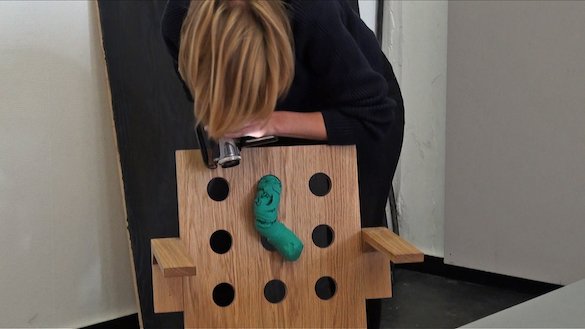

Indeed, a few minutes later, it is even a matter of turning the sculpture 180o and that this “simple act that changes the context of the sculpture completely” can turn it into a model of a space where other sculptures can be shown. Among all the options imagined “in order to make it successful a sculpture”, there is the latent fear that it “looks too much like an object which serves a function”. This never-ending questioning of the nature of the art object and its differentiation with the object stemming from design—i.e with the object meant for a precise use—is funnily exemplified in Personal Matters and Matters of Fact, a dialogue between Hedwig Houben, her self-portrait, and a chair. In a formal sense, this filmed conversation is subtitled with different coloured words which make it possible to tell the speakers apart, with the objects this time not having been endowed with voices. Because these latter are curious to know why they have been created and why in this way, they question the artist, which inevitably gives rise to hilarious reflections from her, as she becomes irritated, especially in the first scene: “It makes me nervous when I get the impression that the chair doesn’t understand me”. The chair, a reproduction of Gerrit Rietveld’s Zig-Zag model, seems to be hallmarked by a Cartesian spirit: pronouncing itself in favour of clear ideas and concepts, is seeking certainty. The self-portrait, a small head made of green plasticine, appears more adventurous, declaring that it, for its part, likes uncertainty. The clichés are indeed there. However, in the next scene, as the chair complains that it is bored and proposes a role-play, it will from then on show an unsuspected imagination, merrily talking to the self-portrait which wonders if it may be something other than a self-portrait: “We don’t necessarily have to represent ourselves”. As Hedwig Houben wants to enact doubt, the self-portrait will enact uncertainty. There then follows an extremely interesting discussion about how the artist manufactured the two protagonists and, while she admits that she has delegated the making of the chair to a carpenter and that the self-portrait is disappointed, the chair explains that this is not what is important to it, so similar is it, which the self-portrait struggles to understand. Does looking like, being a lookalike, prevent something from being real, the two objects wonder. “You’re both made to represent a copy” the artist hurls at them. And if the self-portrait pretends to want to self-destruct while at the same time requiring its creator’s help to do so, it is then the better to challenge her, in a conclusion with slightly Beckett-like undertones.
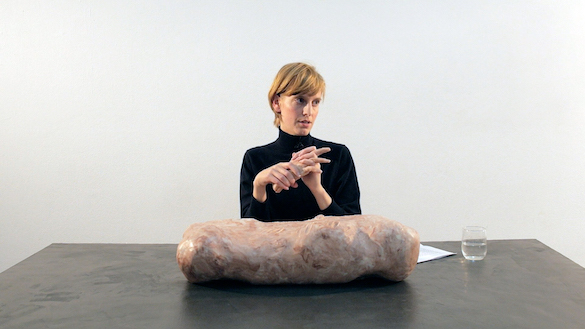
Is the chair produced by a craftsman, based on a model, a copy or an original? It does not know what to answer to this, any more than does the artist who, in fact, will go so far as to ask her self-portrait what it would be without her. With regard to this interest in copies, Hedwig Houben says that it came about when, as a student walking down chic shopping streets, then more working-class streets of shops, she noticed her inclination to prefer imitations of necklaces in the displays of large chain stores to the “originals” in jewellers’ shop windows. In these embodiments of desire, just as in advertisements, “representation is stronger than the object itself”, to use her own words.3
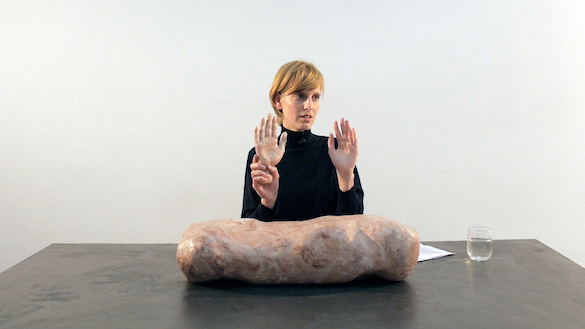
Hedwig Houben, The Hand, the Eye and It, 2013. Performance; video 20′. Video still. Courtesy Galerie Fons Welters, Amsterdam.
Beneath its highly theoretical appearances, Hedwig Houben’s approach to sculpture is in reality very intuitive. Her line of thinking finds its source and is incarnated in her praxis, as dictated by her. Her desire for objects is all the greater because she has trouble producing them, creating her œuvre like a corpus in the offing, passing it off as an avowal of unproductiveness. Is the work the finality of the creative process, or is this latter autotelic? This is probably the basic question to be recognized here. Perhaps material consciousness as the American sociologist Richard Sennett4 endeavours to define it in The Craftsman—which is actually one of the readings laid claim to by Houben—can introduce one or two answers. Is there a practical kind of knowledge other than technical? A form of knowledge that stems from expertise without opposing it, but which is not conceived as being superior to it, either? While Sennett deals with this subject by way of case studies like that of doctors at a conference, a short history of pottery and bricks, Hedwig Houben applies it to the field of art. The person Sennett calls the craftsman in a broadened notion of what it is usually thought of as being, fulfills in “the desire to do a job well for its own sake”, in “a dialogue between concrete practices and thinking”. There is a knowledge that the hand acquires by touch and movement, a knowledge than cannot be scaled down to theorization. It is precisely to an auscultation of this knowledge that Hedwig Houben applies herself in The Hand, the Eye and It, by way of an exploration of the conditions of creation and of what presides over it. How is information transmitted between the eye and the hand? How do the hands collaborate? By literally plunging her own hands into what closely resembles the metaphor of the creator’s body, i.e. that “It” above-mentioned, Houben tries to bring to the fore what she calls “invisible concepts”, those which, according to her, give the hands the instructions for creation, to wit “feelings, memories, references…”. She then explains, in a striking way, that the eyes cannot anticipate the creation to be: “It appeared in front of them, but the eyes had no idea about what was happening and who was giving the instructions to”. With Houben, personification is in fact the name of the game: from geometric solids which are described by their character in Color and Shapes, a Short Explanation of My Artistic Practice (2010) to this hand that has been individualized and moves between the artist’s in The Hand, the Eye and It.6
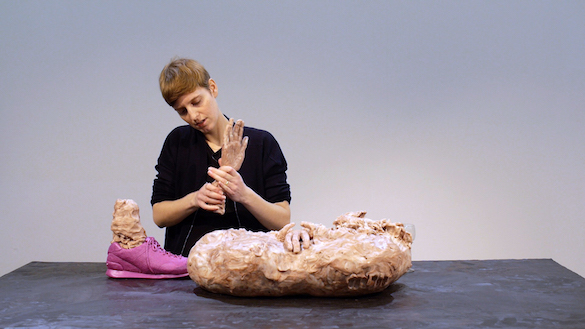
Hedwig Houben, The Hand, The Eye, It and The Foot, 2015.
Performance; video 25′. Video still. Courtesy Galerie Fons Welters, Amsterdam.
For while objects are humanized, the artist, for her part, tries to take a really close look at herself, the better to analyze herself: “… by deconstructing myself and reinterpreting these situations, I hope to get more insights on my appearances and [about] the demystification of myself”, she declares at the very beginning in Five Possible Lectures on Six Possibilities for a Sculpture (2012), a lecture that came across like the retrospective of the project Six Possibilities for a Sculpture (2009-2012). Juggling between her two identities as sculptress and performer, after being introduced as having worked “in collaboration with Hedwig Houben”, she suddenly comments: “ So Hedwig continues the talk, explains…”.
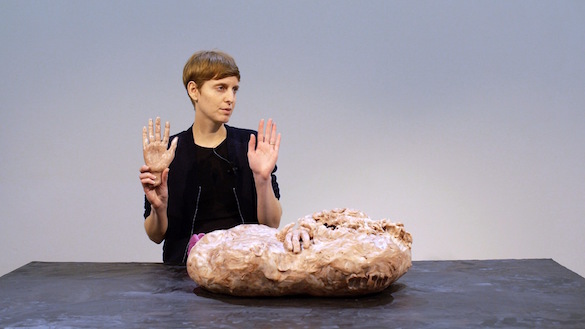
Hedwig Houben, The Hand, The Eye, It and The Foot, 2015. Performance; video 25′. Video still. Courtesy Galerie Fons Welters, Amsterdam.
There is something both easy and impossible about writing about Hedwig Houben’s work. Easy because the issues she broaches are shared by anyone who is interested in art, from whatever standpoint, because these aporias are fertile, though they are often hackneyed, and at times even a bit corny—which, essentially, is the case with any issue that is just a tad universal, the counterpart of all philosophy being that of the pub— too, because it is not hard to summon up ad hoc references like the writings of Clément Rosset (The Real and its Double or The Real: Treatise on Idiocy), and the interpretation theories of Nietzsche, Davidson, Sontag and Shusterman, among others. But to do as much here would undoubtedly be a false start, so pointedly does it seem that questions rooted in experience must be matched by attempts to respond thereto.
Impossible, precisely, for this same reason.
“ Is our consciousness of things independent of the things themselves ? asks Sennett. Are we aware of words in the way we feel an intestine by touch ?”7 (He is referring here to a meeting during which doctors are looking at the image of an operation on the intestine, but the word “intestine” can be replaced here by many others). Still this issue of the possibility or impossibility of an equivalence between two fields: translation is always just translation, the “argument about” is only ever what it is; it is not a matter, when talking about art, of trying to do anything else, of getting beyond this discursive condition (what else could one do? in what direction?). It is once again in Sennett’s writing that we find mention of an anecdote that is particularly illuminating on this subject, quoting Edgar Degas who allegedly said to Mallarmé one day: “ I have a wonderful idea for a poem but I can’t seem to work it out”, to which the poet replied: “My dear Edgar, poems are not made with ideas, they are made with words”. Should a “successful” work nevertheless render any argument about it futile or, on the other hand, should it be the matrix of many different rich and probing arguments? How are we to transcribe in the discourse the sub-discursive intimacy produced by this relation to the work? And why? The discourse is a fundamentally different one, developing by way of quite different material (although Houben’s works are also partly incarnated in language). Is material consciousness thus the one that is galvanized in our relation to the artwork? If so, do scales of consciousness co-exist? (Do we necessarily comprehend in different ways two types of argument which do not seem to be that different— for example, Hedwig Houben’s argument about Hedwig Houben, and my argument about Hedwig Houben? When we hear Hedwig Houben comment, in her asides, about what Hedwig Houben is saying and doing, is this absolutely different from when people read me commenting about what Hedwig Houben is saying and doing? My stuff is the word, Houben’s is the same, to a great extent. Perhaps my argument is like those supermarket necklaces, while hers is the jeweller’s?) In a very recent piece, The Collector and its Host (2015), Hedwig Houben disappears, as does her voice, replaced by instructions left to the Host of this set of modulable shelves (called the Collector), designed to present reproductions of the characters in her earlier pieces. A work to be set in motion throughout its display in the show, in which we can further notice the care given to the design of the shelves more than the rare objects scattered along them. An artist with a work in the offing, we were saying, but as well as the performer expressing it in The Hand, the Eye, It and the Foot: “there is no guarantee of success”.
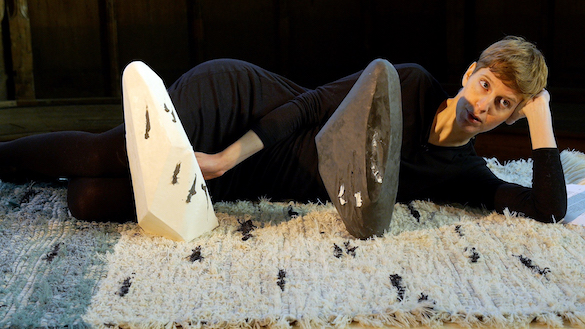
Hedwig Houben, The Good, The Bad, The Happy, The Sad, 2014.
Performance; video 19’31. Video still. Courtesy Galerie Fons Welters, Amsterdam.
1 Jan Van Woensel in an unpublished text put out after a visit to Hedwig Houben’s studio at HISK, Ghent, in 2010.
2 “I use myself as a sort of subject, of volunteer in my own practice”, during an interview with Vanessa Desclaux at La Loge, Brussels, 13 June 2013. https://vimeo.com/71021934
3 Idem.
4 Richard Sennett, The Craftsman, Penguin Books, 2008. See in particular Chapter 4 “Material Consciousness”.
5 Idem, p. 9.
6 On this, chapter 5, “The Hand”, again in The Craftsman, is especially illuminating.
7 Richard Sennett, The Craftsman, op. cit., p. 120.
“Un-Scene III”, from 30 May to 9 August 2015, Wiels, Brussels; « Disappearing Acts », LIAF, (Lofoten International Art Festival), from 28 August to 27 septembre 2015; Hedwig Houben is nominated for the Prix de Rome 2015, exhibition of the shortlisted artists at De Appel Arts Centre, Amsterdam 21 Nov 2015-17 Jan 2016.
- From the issue: 75
- Share: ,
- By the same author: Kate Crawford | Trevor Paglen, Thomas Bellinck, Christopher Kulendran Thomas, Giorgio Griffa, Pamela Rosenkranz,
Related articles
Céleste Richard Zimmermann
by Philippe Szechter
Julien Creuzet
by Andréanne Béguin
Anne Le Troter
by Camille Velluet

